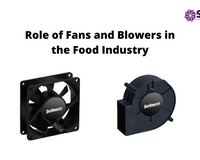Tangential fans or cross flow fans are one of the popular types of industrial fans used today. These industrial fans are commonly used in industrial systems where uniform airflow is required. Featuring a unique impeller design, these fans offer several benefits, which makes them an integral part of an industrial cooling and ventilation system. These industrial fans are used in the heating, ventilation and air conditioning (HVAC) system, process engineering units, drying technologies, etc. However, the scope of application of tangential fans is not limited to the aforementioned applications. Therefore, if you are willing to use these fans for your industrial applications, it is important to know how it really works along with its benefits. This post introduces the industrial tangential fans followed by a discussion about its working principle and benefits.
Industrial Tangential Fans
The tangential fans are modified versions of industrial axial fans. These fans are also known as cross flow fans. These fans were introduced by Paul Mortier in the year 1893. However, in modern cooling systems, these fans have gotten utmost popularity. These fans are specially recognized for their compact design and uniform laminar air throughput.
Construction of Tangential Fans
The industrial fans feature a driving motor, hub, blades, and housing as main components. The secondary components like mounting bearing, are used for installation purposes.
• The primary construction of these fans features the forward curved elongated blades mounted on the hub.
• The hub is connected to the driving shaft of an electric motor.
• The entire motor, driving shaft, blades, and hub assembly are enclosed in a vortex housing or casing.
This overall construction is compact and therefore is preferred in several industrial applications. Due to their enclosed vortex casing, an elongated tubular structure is seen in these fans. Therefore, they are also known as tubular fans.
Working Principle of Tangential Fans
The tangential/tubular fans work in the following manner.
• As the electric motor is turned on, the hub rotates in response to the rotary motion of the driving shaft. The rotary motion of the hub causes the forward motion of the curved elongated blades.
• Since the blades are forward curved, the equilibrium is formed from the hub to the ending tip of the impeller. This causes the air intake from the inlet section on the vortex casing.
• As the air enters, it is carried forward by captivating between the gaps between the blades. Then the compressed air is ejected out of the vortex casing. The air throughput on each output remains uniform and laminar in nature.
The above-discussed working principle and construction of the industrial tangential or tubular fans make them ideal for industrial applications.
Benefits of Using Industrial Tangential Fans
The following benefits of cross flow fans make them a perfect choice for HVAC, compact ventilation, industrial cooling, aerospace cooling, and ventilation applications.
• Compact Design
• Low Operational Noise
• Uniform Laminar Air Throughput
• Output Air Exposure to Wide Area
• Low Maintenance
• Low Mechanical Vibrations
• No or Negligible Pressure Drop or Backward Air Drag
To gain all the benefits of industrial tubular fans, one must consider buying high-quality products from reliable suppliers like Sofasco. The company is a global supplier of industrial axial fans, radial fans, cross-flow fans, etc. The cross flow fans are one of their premium products. Since 1981, the company has been supplying high-quality industrial fans for industries like electrical, telecommunication, manufacturing, etc.












